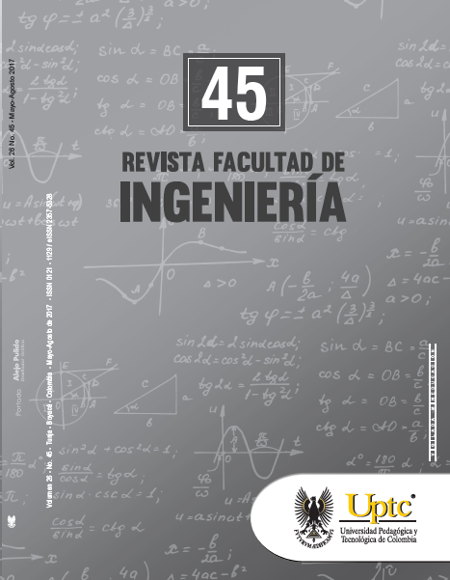Visualization of urban floodplains in the Amazon foothill using the geo-inspired model of natural vector multi-agents (AVNG)

Abstract
In the specialized literature, there are different ways to calculate and display flooded areas by geographical entities (rivers or streams), using mathematical and physical models in 1D and 2D areas; also, the use of tools such as Geographic Information Systems (GIS), the diffuse logic, the neural networks, and the genetic algorithms, among others, has been reported. This article describes the use of Geo-inspired Natural Vectors Agents (AVNG). The AVNG is founded on the agent concept, by integrating the GIS vector model to achieve the construction of an element capable of dynamically representing a geographical entity (vector) from two behaviors: the natural and the induced (Natural Agent); thus, generating an approximation to environmental management. In order to implement the AVNG conceptual model, we studied the Colombian Amazon foothills, where flash floods in urban areas cause material disasters and loss of human lives.
Keywords
Bio-inspired computing, Environmental computers, Environmental management, Flooded areas
References
- Secretaría General de la Comunidad Andina, "Agenda ambiental Andina 2012-2016, Bolivia, Colombia, Euador y Peru," Pull Creativo SRL, Lima-Peru, 2012.
- M. Batty, "GeoComputation using cellular automata," in Geocomputation, pp. 95-126, 2000.
- A. W. Jayawardena, E. D. Perera, B. Zhu, J. D. Amarasekara, and V. Vereivalu, "A comparative study of fuzzy logic systems approach for river discharge prediction," Journal of hydrology, vol. 514 (1), pp. 85-101, 2014. DOI: http://doi.org/10.1016/j.jhydrol.2014.03.064. DOI: https://doi.org/10.1016/j.jhydrol.2014.03.064
- S. Vitabile, V. Conti, C. Militello, and F. Sorbello, "An extended JADE-S based framework for developing secure Multi-Agent Systems," Computer Standards & Interfaces, vol. 31 (5), pp. 913-930, Sep. 2009. DOI: http://doi.org/10.1016/j.csi.2008.03.017. DOI: https://doi.org/10.1016/j.csi.2008.03.017
- S. H. Chen, A. J. Jakeman, and J. P. Norton, "Artificial Intelligence techniques: An introduction to their use for modelling environmental systems," Mathematics and Computers in Simulation, vol. 78 (2-3), pp. 379–400, Jul 2008. DOI: http://doi.org/10.1016/j.matcom.2008.01.028. DOI: https://doi.org/10.1016/j.matcom.2008.01.028
- E. E. Millán Rojas, and J. N. Perez Castillo, " Una aproximación de la gestión ambiental para la predicción de áreas inundables en el piedemonte amazónico, usando agentes naturales por medio de la computación bioinspirada," in Twelfth LACCEI Latin American and Caribbean Conference for Engineering and Technology, pp. 1-9, 2014.
- M. S. Horritt, and P. D. Bates, "Evaluation of 1D and 2D numerical models for predicting river flood inundation," Journal of Hydrology, vol. 268 (1-4), pp. 87-99, Nov. 2002. DOI: http://doi.org/10.1016/S0022-1694(02)00121-X. DOI: https://doi.org/10.1016/S0022-1694(02)00121-X
- Y. Hammam, A. Moore, and P. Whigham, "The dynamic geometry of geographical vector agents," Computers, Environment and Urban Systems, vol. 31 (5), pp. 502-519, Sep. 2007. DOI: http://doi.org/10.1016/j.compenvurbsys.2007.08.003. DOI: https://doi.org/10.1016/j.compenvurbsys.2007.08.003
- D. Weyns, H. V. D. Parunak, F. Michel, T. Holvoet, and J. Ferber, "Environments for multiagent systems state-of-the-art and research challenges," Environments for multi-agent systems, vol. 3374, pp. 1-47, 2005. DOI: https://doi.org/10.1007/978-3-540-32259-7_1
- H. Parunak, R. Bisson, and S. A. Brueckner, "Agent interaction, multiple perspectives, and swarming simulation," in Proceedings of the 9th International Conference on Autonomous Agents and Multiagent Systems, 2010.
- O. El-Kholy, The world environment 1972–1992: Two decades of challenge, Netherlands: Springer, 2012.
- G. A. Espinoza, Gestión y fundamentos de evaluación de impacto ambiental, Santiago de Chile: BID/CED, 2006.
- L. V. Mora, Gestión ambiental sistémica, Sigma, 2001.
- M. J. Wooldridge, An introduction to multiagent systems, Liverpool: Summer, 2009, pp. 1-39.
- J. Ferber, Multi-agent systems: an introduction to distributed artificial intelligence, Manchester: Addison-Wesley, 1999.
- R. A. Johnson, Advanced euclidean geometry, Courier Corporation, 2013.
- JADE, "jadeworld". Available: http://www.jadeworld.com/developer-center/download-jade/.
- Geotools.org, "Geotools.org". Available: http://geotools.org/.
- A. V. Sandita, and C. I. Popirlan, "Developing A Multi-Agent System in JADE for Information Management in Educational Competence Domains," Procedia Economics and Finance, vol. 23, pp. 478-486, 2015. DOI: http://doi.org/10.1016/S2212-5671(15)00404-9. DOI: https://doi.org/10.1016/S2212-5671(15)00404-9
- Open Geospatial Consortium, "OGC". Available: http://www.opengeospatial.org/.
- I. Turton, "Geo tools," Open source approaches in spatial data handling, vol. 2, pp. 153-169, 2008. DOI: http://doi.org/10.1007/978-3-540-74831-1_8. DOI: https://doi.org/10.1007/978-3-540-74831-1_8
- IDEAM, «Datos IDEAM,» Available: http://www.ideam.gov.co.
- L. Sauvé, "Educación ambiental y ecociudadania. Dimensiones claves de un proyecto político-pedagógico," Revista Científica, vol. 1 (18), pp. 12-23, 2014. DOI: https://doi.org/10.14483/23448350.5558
- D. J. Marceau, and I. Benenson, Advanced Geo-Simulation Models, Bentham Science Publishers, 2011. DOI: https://doi.org/10.2174/97816080522261110101